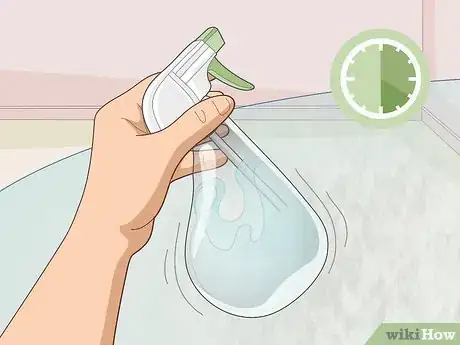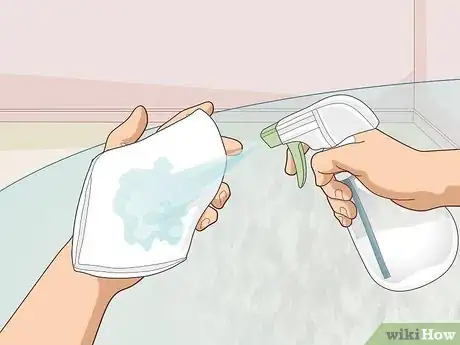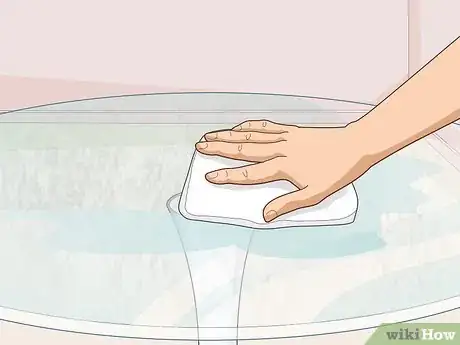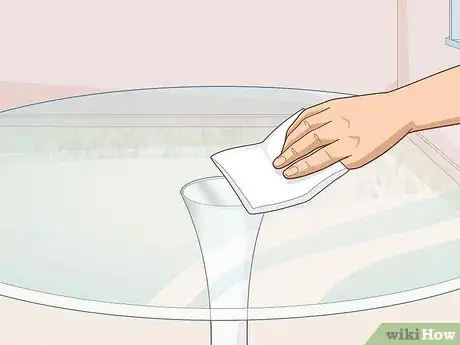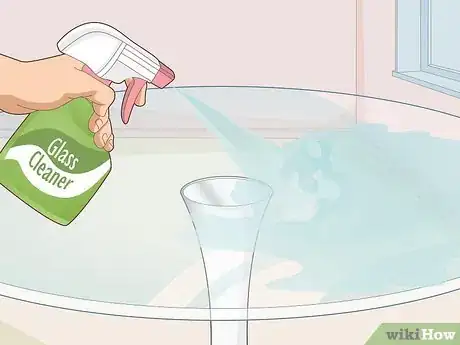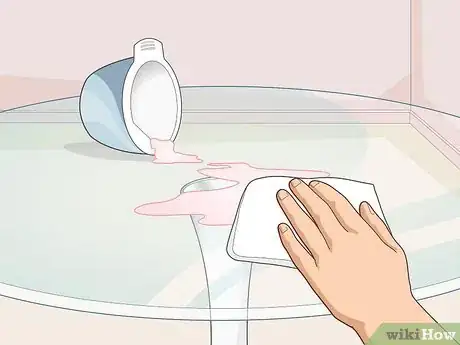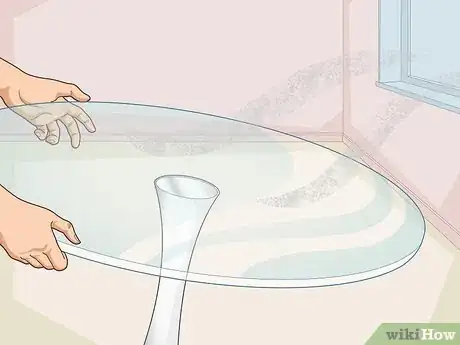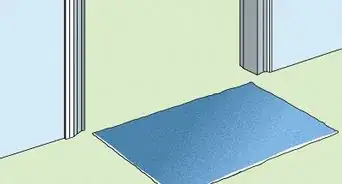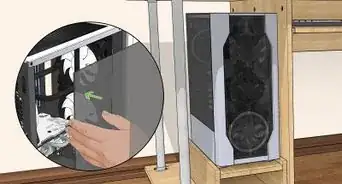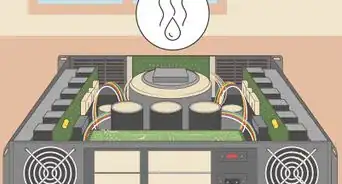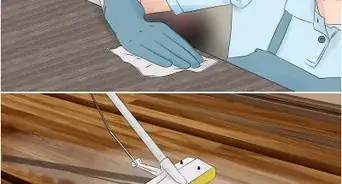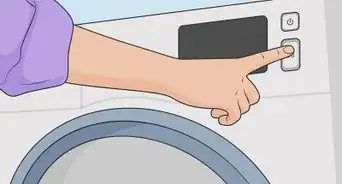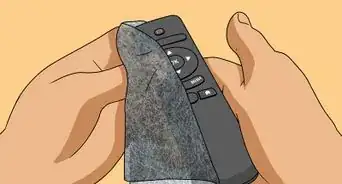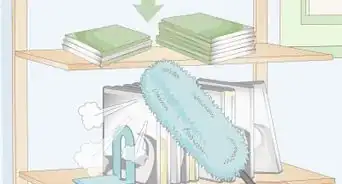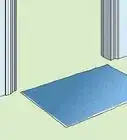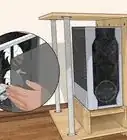This article was co-authored by Jon Gholian. Jon Gholian is a Cleaning Specialist and the Founder of Cleany, a home and office cleaning concierge service based in New York City, New Jersey & Miami. Cleany specializes in providing quality cleaning and handyman services to all their customers. All Cleany employees are insured, bonded, and professionally trained. Cleany has been featured in the New York Times, Bravo & Redfin.
There are 12 references cited in this article, which can be found at the bottom of the page.
This article has been viewed 48,911 times.
It doesn’t take long for a coat of dust to ruin the clarity and shine of a glass-top table. Fortunately, it takes even less time to safeguard your table and keep dust from becoming as much of a problem in the future. All you need is a selection of everyday household items and a basic understanding of the kind of treatment your glass needs to look its best.
Steps
Dust-Proofing the Glass with Fabric Softener
-
1Combine 4 parts water and 1 part liquid fabric softener in a spray bottle. Pour the fabric softener into the empty bottle until it’s roughly ⅕ of the way full. Then, fill it the rest of the way up with water. This should give you just the right proportions of both ingredients.
- If you add too much fabric softener, it could produce a sticky film on the surface of the glass.
- It doesn’t matter whether you use cold water or warm water. Just make sure that it’s clean and fresh from the tap.
Tip: Use distilled or purified water, if you have any on hand. These types of water are free of minerals, which could create tiny scratches in the glass, and chemicals, which can result in unsightly buildup.[1]
-
2Shake the bottle for 20-30 seconds to blend your ingredients. Double-check that the lid is screwed on tightly to avoid making a mess. Following a vigorous shake, your finished solution should have a somewhat milky consistency only slightly thicker than water.
- Be sure to shake the bottle again right before you start spraying. Some separation may occur as the solution sits.
Advertisement -
3Spray a small amount of solution onto a microfiber cloth or soft, lint-free towel. Fold your cloth or towel once or twice to form a large pad, then spritz it just enough times to dampen it. You’ll be using this to do your dusting.[2]
- Don’t use paper towels or towels that are not lint-free to dust glass. Not only do they typically leave behind streaks and irritating paper debris, they’re also more likely to cause scratches than softer items.[3]
-
4Wipe down the entire table. The damp cloth will take care of even the thickest blanket of dust that’s accumulated on the surface. Make sure that you give every part of the tabletop some attention. If you miss a spot, it won’t benefit from your solution’s anti-dust properties.
- If you notice standing moisture on the table when you’re done, you’ve probably used too much solution. Flip your dusting pad over and use the dry side to sponge up the excess liquid.
- When applied to glass and other smooth surfaces, this simple solution works by creating a barrier that prevents dust and other tiny particles from settling.[4]
-
5Buff the glass with a separate cloth until it's crystal clear. Now, grab a second microfiber cloth or soft towel and go back over every part of the table you just dusted. This will pick up any remaining dust while also removing lingering traces of solution that might otherwise dry and create noticeable spots. When you’re done, it should be like looking at a brand new table!
- Be careful not to touch the table with your bare hands after drying it, or you could leave smudges or fingerprints and ruin all of your hard work.
- You can use your fabric softener solution in place of ordinary glass cleaner for future dustings or in addition to it as an extra measure of protection.
Keeping Your Glass Table Pristine
-
1Wipe your table with fabric softener sheets in between dustings. If your glass-top table is a dust magnet but you don’t want to have to make dusting a daily chore, one easy fix is to hit it with a dry fabric softener sheet every couple of days. These will offer most of the same perks as your homemade solution, only with greater ease-of-use and disposability.[5]
- Another advantage of dryer sheets is that they help to eliminate dust-attracting static electricity, which has a way of building up on glass surfaces.[6]
- Keep in mind that a quick pass with a fabric softener sheet may not banish dust as effectively as a long-lasting liquid coating.
-
2Use a specialty glass cleaner for regular dustings. Glass cleaners are designed to fully remove dust, dirt, stains, and other substances that can spoil the look of glass surfaces. For best results, be sure to buy a glass cleaner that contains ammonia. This is where most of the product’s grime-fighting power will come from. Wipe your table weekly to clean up any visible dust.[7] [8]
- A quality glass cleaner doesn’t have to cost you an arm and a leg. In fact, many of the highest-rated products on the market are priced at less than $5 a bottle.[9]
- If you have qualms about buying products filled with strange chemicals, you can also try making your own all-natural glass cleaner using 2 cups (470 mL) of distilled water, 1⁄2 cup (120 mL) of vinegar, and a few drops of your favorite essential oil.[10]
-
3Avoid dry-dusting your glass table. Always dampen your dusting tool before you put it to glass. Bone-dry cloths and towels will only push dust and grit around. Over time, this type of rough treatment can lead to serious scratches that will rob your table of its beauty.
- The only time it’s acceptable to use a dry cloth or towel on your table is right after you’ve used a wet one. Even then, it’s important to select a soft to minimize the risk of damage.
-
4Deal with spills as soon as they occur. If you happen to get something you’re eating or drinking on your glass table, wet a soft cloth with warm water and use it to wipe up the mess right away, then clean the glass as you normally would. Many foods and beverages become sticky when they dry. Because of this, they can attract more dust and hold onto it stubbornly.[11]
- A little distilled white vinegar or liquid dish soap can help cut through greasy food residue.
-
5Move your table away from areas where dust tends to be a problem. If possible, situate the table near the center of the room, far away from dust-caked window blinds and fuzzy ceiling fans. That way, it will be less likely to serve as a landing pad for drifting particles. Other places where dust tends to lurk include the tops of cabinets, deep in the fibers of high rugs and carpets, and around air vents.[12]
- If you notice that the dust on your table is thicker in some spots than others, pay attention. The way the dust is distributed could offer a clue as to where it’s coming from.[13]
Tip: Staying on top of your vacuuming (along with regular dusting) is the best way to cut down on the overall amount of dust in the air.
Expert Q&A
Did you know you can get expert answers for this article?
Unlock expert answers by supporting wikiHow
-
QuestionHow can I keep dust off of my glass table?
 James SearsJames Sears leads the customer happiness team at Neatly, a group of cleaning gurus based in Los Angeles and Orange County, California. James and the team have nine years of experience and offer green cleaning, interior and exterior window washing, and general apartment cleaning services. He provides transformative cleaning experiences by reducing clutter and renewing your home environment. James is a Trustee Scholar at the University of Southern California.
James SearsJames Sears leads the customer happiness team at Neatly, a group of cleaning gurus based in Los Angeles and Orange County, California. James and the team have nine years of experience and offer green cleaning, interior and exterior window washing, and general apartment cleaning services. He provides transformative cleaning experiences by reducing clutter and renewing your home environment. James is a Trustee Scholar at the University of Southern California.
House Cleaning Professional
Warnings
- Before using a particular glass cleaner, check the cleaning guidelines provided by your table’s manufacturer to see if it’s safe. If the glass has been specially treated, the wrong cleaner could make it more susceptible to discoloration, etching, and other issues.⧼thumbs_response⧽
Things You’ll Need
Dust-Proofing the Glass with Fabric Softener
- Spray bottle
- Liquid fabric softener
- Water
- Microfiber cloth or soft, lint-free towel
Keeping Your Glass Table Pristine
- Fabric softener sheets
- Glass cleaner
- Microfiber cloth or lint-free towel
- Distilled white vinegar or liquid dish soap (optional)
References
- ↑ https://www.usgs.gov/special-topic/water-science-school/science/hardness-water/
- ↑ https://www.housebeautiful.com/uk/lifestyle/cleaning/a27607054/fabric-conditioner-glass-cleaning-hack/
- ↑ Jon Gholian. Cleaning Specialist. Expert Interview. 19 April 2021.
- ↑ https://www.housebeautiful.com/uk/lifestyle/cleaning/a27607054/fabric-conditioner-glass-cleaning-hack/
- ↑ https://www.thesun.co.uk/fabulous/3328366/dusting-hacks-clean-trick-fabric-conditioner/
- ↑ https://www.wonderopolis.org/wonder/how-do-dryer-sheets-prevent-static-cling
- ↑ James Sears. House Cleaning Professional. Expert Interview. 28 August 2019.
- ↑ https://www.bobvila.com/articles/best-glass-cleaner/
- ↑ https://www.businessinsider.com/best-glass-cleaner
- ↑ https://www.bhg.com/homekeeping/house-cleaning/cleaning-products-tools/best-homemade-window-cleaner/
- ↑ https://homesteady.com/clean-glasstopped-dining-table-7719.html
- ↑ https://www.apartmenttherapy.com/we-bet-we-can-guess-the-6-dustiest-spots-in-your-home-right-now-222003
- ↑ https://www.bobvila.com/slideshow/9-things-you-re-doing-to-make-your-home-dustier-49819
- ↑ James Sears. House Cleaning Professional. Expert Interview. 28 August 2019.

